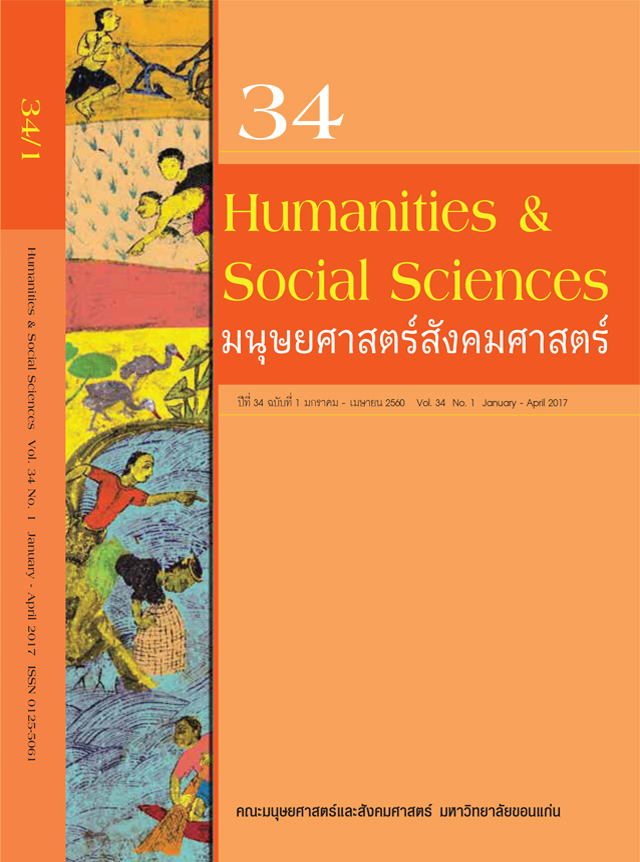คุณประโยชน์แห่งพุทธศาสนาต่อการส่งเสริมฐานะทางเศรษฐกิจของครัวเรือนในชนบทอีสาน: ศึกษากรณีอำเภอเมืองขอนแก่น จังหวัดขอนแก่น; The Usefulness of Buddhism in Enhancing the Economic Conditions of the RuralE-san Households: A Case Study of Muang District, KhonKaen
Keywords:
คุณประโยชน์, เศรษฐกิจครัวเรือน, เศรษฐศาสตร์แนวพุทธ, ฐานะทางเศรษฐกิจ, คุณภาพชีวิตดีงาม, Usefulness, Household economy, Buddhist economics, Economic condition, Quality of good lifeAbstract
การศึกษาวิจัยมีวัตถุประสงค์1) เพื่อศึกษาหลักธรรมทางพุทธศาสนาที่ส่งเสริมฐานะทางเศรษฐกิจของครัวเรือน 2) เพื่อวิเคราะห์ความสัมพันธ์ระหว่างหลักธรรมทางพุทธศาสนากับการส่งเสริมฐานะทางเศรษฐกิจของครัวเรือน และ 3) เพื่อประเมินการได้คุณภาพชีวิตที่ดีในด้านเศรษฐกิจของครัวเรือนในชนบทอีสาน ซึ่งเป็นกรณีศึกษาเฉพาะในเขตอำเภอเมืองขอนแก่น จังหวัดขอนแก่นเท่านั้น
ผลของการศึกษาวิจัย พบว่า หลักพุทธธรรมที่ส่งเสริมฐานะทางเศรษฐกิจของครัวเรือนชนบทอีสานสามารถแยกเป็นด้านต่างๆได้ดังนี้ ก) ด้านการผลิต หลักพุทธธรรมที่ส่งเสริมในระดับมากที่สุด ก็คือหลักคิหิสุข (ร้อยละ 89.00) รองลงมา คือ หลักโภคอาทิยะ(ร้อยละ 72.30) ข) ด้านการทำงานเพื่อผลผลิต หลักพุทธธรรมที่ส่งเสริมในระดับมากที่สุด ก็คือ หลักคิหิสุข (ร้อยละ 86.90) รองลงมา คือ หลักทิฎฐธัมมิกัตถะ (ร้อยละ 80.40) ค) ด้านการบริโภค หลักพุทธธรรมที่ส่งเสริมในระดับมากที่สุด คือ หลักคิหิสุข (ร้อยละ 50.80) รองลงมา ก็คือ หลักกุลจิรัฎฐิติธรรม (ร้อยละ 47.40) ง) ด้านการใช้จ่าย หลักพุทธธรรมที่ส่งเสริมในระดับมากที่สุด คือ หลักโภควิภาค (ร้อยละ 57.60) รองลงมาก็คือ หลักคิหิสุข (ร้อยละ 51.30) จ) ด้านการออมและการประหยัด หลักพุทธธรรมที่ส่งเสริมในระดับมากที่สุด คือ หลักกุลจิรัฏฐิติธรรม (ร้อยละ 81.70) รองลงมา คือ หลักคิหิสุข (ร้อยละ 81.40)และ ฉ) ด้านการกระจายผลการผลิต หลักพุทธธรรมที่ส่งเสริมในระดับมากที่สุด คือ หลักกุลจิรัฏฐิติธรรม (ร้อยละ 79.30)รองลงมา คือ หลักคิหิสุข (ร้อยละ 78.50)
ส่วนผลของการวิเคราะห์ความสัมพันธ์ระหว่าง 2 ตัวแปรด้วยสถิติสัมประสิทธิ์สหสัมพันธ์ของเพียร์สัน พบว่า หลักคุณประโยชน์แห่งพุทธศาสนาที่มีผลต่อการส่งเสริมฐานะทางเศรษฐกิจของครัวเรือนในชนบทอีสาน มากที่สุดก็คือ ด้านการทำงานเพื่อผลผลิต (r = 0.94) รองลงมาคือ ด้านการออมและการประหยัด (r = 0.88) และ ด้านการกระจายผลการผลิต (r = 0.86) อย่างมีนัยสำคัญทางสถิติที่ระดับ 0.01 และ 0.50 ตามลำดับ
ส่วนผลของการประเมินการได้คุณภาพชีวิตที่ดี ซึ่งสร้างกรอบการประเมินจากหลักเกณฑ์ของพุทธธรรมตามหลักกามโภคี 10 ประการพบว่า ครัวเรือนในชนบทอีสานส่วนใหญ่มีคุณภาพชีวิตอยู่ในระดับดี คิดเป็นร้อยละ 77.49 (x̄=4.38) รองลงมา คือ ระดับทั่วไป คิดเป็นร้อยละ 14.66 (x̄= 2.93) และ ระดับไม่ดี คิดเป็นร้อยละ 4.97 (x̄= 1.95) ส่วนในระดับดีมาก พบว่ามีเพียงร้อยละ 2.88 (x̄= 4.62) เท่านั้น
Abstract
The research study has the following objectives: 1) To examine the influence of Buddhist doctrines in promoting the economic condition of the rural households,2) To analyze the relationship of Buddhist doctrines inenhancing the economic condition of the rural households, and 3) To evaluate the fulfillment on the quality of life in the economic conditionof the rural e-san households as the case study in Muang districtof Khonkaen province.
The results of the study found that the Buddhist doctrines that principally enhanced the economic condition of the rural e-san households had been divided into different aspects namely, a) on production; the Buddhist doctrine that supported at the highest level is called Gihisukha or the house-life happiness (89.00 %) followed by the so-called Bhoga-ādiya or reasons for earning and having wealth (72.30 %), b) on working for productivity; the Buddhist doctrine that promoted at the highest level isGihisukha (86.90%) followed by Ditthadhammikattha or virtues conducive to temporal welfare (80.40%), c) on consumption; the Buddhist doctrine that mainly fostered at the highest level is Gihisukha (50.80%) followed by Kulaciratthiti-dhamma or reasons for lastingness of a wealthy family (47.40 %), d) on spending; the Buddhist doctrine that assisted at the highest level is Bhogavibhāga or division of money (57.60%) followed by Gihisukha(51.30 %), e) on saving and economizing; the Buddhist doctrine that vividly cherished at the highest level is Kulaciratthiti-dhamma (81.70%) followed by Gihisukha (81.40 %), and f) on the distribution of production; the Buddhist doctrine that wisely contributed at the highest level is Kulaciratthiti-dhamma (79.30%) followed by Gihisukha (78.50 %).
As for measuring the linear correlation between two variables with the statistical analysis of the Pearson’s correlation coefficient indicated that the Buddhist doctrines thatsignificantly affected to economic conditions of the rural e-san households at the highest level is onthe productivity working (r = 0.94)followed by the saving andeconomizing (r = 0.88) and the distribution of production (r = 0.86) with statistical significance at the 0.01 and 0.50 respectively.
However, the results from the evaluation of the attaining the quality of goodlife with the help of the Buddhist doctrines’ criteria well known as Kāmabhogī or ten householders of sense-pleasure found that most rural e-san households have a better life at the good level 77.49% (x̄=4.38) followed by average quality of life at 14.66% (x̄= 2.93) and at poor level4.97% (x̄= 1.95) as for very good level found only at 2.88% (x̄= 4.62).



